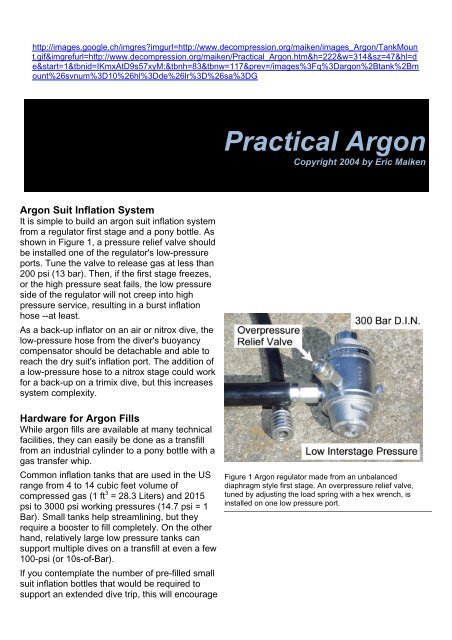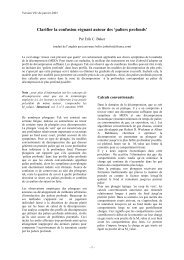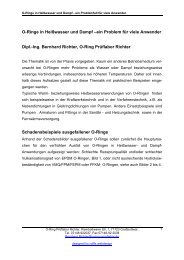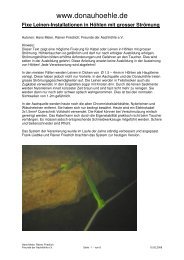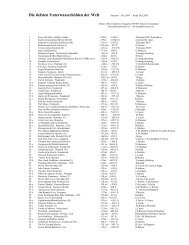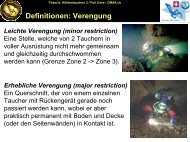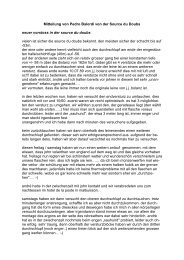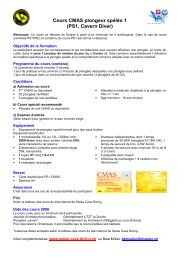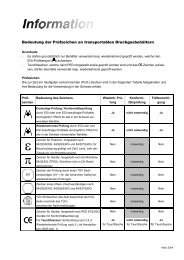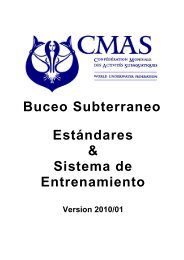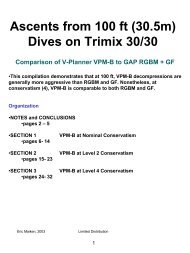Practical Argon - bei Swiss-Cave-Diving
Practical Argon - bei Swiss-Cave-Diving
Practical Argon - bei Swiss-Cave-Diving
Create successful ePaper yourself
Turn your PDF publications into a flip-book with our unique Google optimized e-Paper software.
http://images.google.ch/imgres?imgurl=http://www.decompression.org/maiken/images_<strong>Argon</strong>/TankMoun<br />
t.gif&imgrefurl=http://www.decompression.org/maiken/<strong>Practical</strong>_<strong>Argon</strong>.htm&h=222&w=314&sz=47&hl=d<br />
e&start=1&tbnid=IKmxAtD9s57xyM:&tbnh=83&tbnw=117&prev=/images%3Fq%3Dargon%2Btank%2Bm<br />
ount%26svnum%3D10%26hl%3Dde%26lr%3D%26sa%3DG<br />
<strong>Practical</strong> <strong>Argon</strong><br />
Copyright 2004 by Eric Maiken<br />
<strong>Argon</strong> Suit Inflation System<br />
It is simple to build an argon suit inflation system<br />
from a regulator first stage and a pony bottle. As<br />
shown in Figure 1, a pressure relief valve should<br />
be installed one of the regulator's low-pressure<br />
ports. Tune the valve to release gas at less than<br />
200 psi (13 bar). Then, if the first stage freezes,<br />
or the high pressure seat fails, the low pressure<br />
side of the regulator will not creep into high<br />
pressure service, resulting in a burst inflation<br />
hose --at least.<br />
As a back-up inflator on an air or nitrox dive, the<br />
low-pressure hose from the diver's buoyancy<br />
compensator should be detachable and able to<br />
reach the dry suit's inflation port. The addition of<br />
a low-pressure hose to a nitrox stage could work<br />
for a back-up on a trimix dive, but this increases<br />
system complexity.<br />
Hardware for <strong>Argon</strong> Fills<br />
While argon fills are available at many technical<br />
facilities, they can easily be done as a transfill<br />
from an industrial cylinder to a pony bottle with a<br />
gas transfer whip.<br />
Common inflation tanks that are used in the US<br />
range from 4 to 14 cubic feet volume of<br />
compressed gas (1 ft 3 = 28.3 Liters) and 2015<br />
psi to 3000 psi working pressures (14.7 psi = 1<br />
Bar). Small tanks help streamlining, but they<br />
require a booster to fill completely. On the other<br />
hand, relatively large low pressure tanks can<br />
support multiple dives on a transfill at even a few<br />
100-psi (or 10s-of-Bar).<br />
If you contemplate the number of pre-filled small<br />
suit inflation bottles that would be required to<br />
support an extended dive trip, this will encourage<br />
Figure 1 <strong>Argon</strong> regulator made from an unbalanced<br />
diaphragm style first stage. An overpressure relief valve,<br />
tuned by adjusting the load spring with a hex wrench, is<br />
installed on one low pressure port.
DIY style self-sufficiency. Figure 2 shows a photo<br />
of a gas transfer whip that I made from old<br />
regulator parts, and hardware from<br />
McMaster-Carr. Airspeed Press has good<br />
references to help you set up your own fill<br />
capabilities.<br />
The North American CGA #580 fittings for<br />
industrial argon cylinders are the same as other<br />
important inert diving gases (including He, Ne,<br />
and N 2 ). Figure 3 shows interchangeable<br />
SCUBA, CGA, and pipe fittings that can be used<br />
to move gas with a gas transfer whip. For worldtravelers,<br />
the common denominator in high<br />
pressure gas fittings are the US National Pipe<br />
Thread (NPT), and British Standard Taper (BST).<br />
As long as you have adaptors to these threads,<br />
local gas bottle fittings can be attached to your<br />
gear.<br />
Apart from a LDS with a well-stocked diving gas<br />
station, welding shops are a traveling gas diver's<br />
best friend. With some planning, it is easy to<br />
arrange to pick up argon and other gasses --<br />
even in remote areas. Make sure that in addition<br />
to specifying the gas that you want, that you also<br />
note the valve threads --this will help avoid mixups,<br />
where, for example, you might be<br />
mistakenly given welder's <strong>Argon</strong>/CO 2 . If you<br />
travel without a booster, it's best to take the<br />
entire supply cylinder to the fill site.<br />
Some of the other suit inflation candidates<br />
considered in the article Why <strong>Argon</strong>? require<br />
fittings that are not commonly available.<br />
Nonetheless, for completeness, we'll consider<br />
less practical gases, such as carbon dioxide and<br />
sulfur hexafluoride, which are supplied in a<br />
liquefied form. There are efficient ways to<br />
transfer liquefied gases from cylinder to cylinder,<br />
involving heaters and snorkels, however, most<br />
divers would prefer to rely on a simple gas<br />
transfer hose. If you did use a fill whip to transfer<br />
gas from a liquefied source to a suit inflation<br />
bottle, the process would be slow and pressure<br />
in the suit bottle would be few hundred psi (10s<br />
of Bar) --at most. Even if you could transfer<br />
liquefied gas to your inflation bottle, the<br />
possibility of shooting liquid into your suit should<br />
discourage you from doing this. In an extreme<br />
case, the high pressures and low temperatures<br />
at depths in excess of 500 ft (150 m) could also<br />
cause a number of problems with SF 6 . The gas<br />
in the diver's suit would tend to revert to liquid,<br />
and the equilibrium vapor pressure of the gas<br />
over liquid in the inflation bottle would not be<br />
Figure 2 A pressure gauge, coupled to a standard industrial<br />
pneumatic fitting, is used to adjust the inflation regulator's<br />
interstage pressure and also the pressure relief valve's blowoff<br />
pressure. Other fittings are shown as examples of other<br />
convenient utilities that can be hooked-up to SCUBA for<br />
purposes such as lift bag inflation, or driving a booster pump.<br />
Figure 3 DIY O 2 -Clean gas transfer whip. Stainless steel<br />
fittings are used for components that are changed frequently.
sufficient to build interstage pressure for delivery<br />
through a regulator.<br />
Rigging<br />
There are many options for placement of the<br />
inflation gas bottle. Rigging as a stage, or<br />
attached upside down to the back plate are likely<br />
the cleanest configurations that allow easy<br />
access to the valve. Figure 5 shows a tank<br />
mounted configuration, which is suitable for large<br />
pony bottles that can hold enough gas for many<br />
dives.<br />
Alternatively, military swimmers incorporate<br />
inflation gas into the diver's dress independent of<br />
the UBA by placing a small gas tank into a<br />
pocket on the diver's hip. This configuration may<br />
be impractical for drysuits with hip utility pockets.<br />
Figure 4 Interchangeable CGA and SCUBA fittings at the end<br />
of a gas transfer whip<br />
Safety<br />
User vigilance is essential to minimize the risk of<br />
tragically mistaking inflation gas for breathing<br />
media (Reference 4). Figure 6 illustrates a label<br />
that identifies the cylinder contents as argon,<br />
which is not suitable for breathing.<br />
Another safety issue arises if the diver is using a<br />
helmet or full-face mask with a dry hood or neck<br />
dam above a dry suit inflated with argon. If argon<br />
leaks above the neck seal, into the diver's<br />
oral/nasal, then narcosis or asphyxiation could<br />
result from inspired argon.<br />
There are a number of safety advantages<br />
associated with attaching a suit inflation bottle<br />
directly to the drysuit. Principally that suit inflation<br />
gas stays with the diver, rather than with the<br />
harness. This preserves inflation capability for<br />
cases when a diver doffs their tanks on the<br />
surface to expedite boarding a vessel.<br />
Additionally, if the need for in-water<br />
recompression arises, then the afflicted diver can<br />
reenter the water with a harness for therapy<br />
stages without struggling to don a full set.<br />
Figure 5 A large tank-mounted pony bottle is not as<br />
streamlined as a small bottle fixed to the back plate.<br />
Nonetheless, one fill supports multiple dives and even a very<br />
low pressure partial fill will be adequate for a long<br />
decompression dive.<br />
Operations<br />
Prior to diving, residual atmospheric air should<br />
be purged by inflating and venting the dry suit a<br />
few times with argon to eliminate comparatively<br />
high conductivity air and water vapor. For<br />
shallow dives, purging by a couple full inflations<br />
and dumps is particularly important for insuring
that your suit is actually inflated with nearly 100%<br />
argon.<br />
In contrast to surface preparation, venting suit<br />
gas during a dive actively transports heat away<br />
from the diver. While you need to vent gas that<br />
expands during a controlled ascent, remember to<br />
tighten the suit dump valve a bit for<br />
decompression stops to avoid accidental loss of<br />
warm gas. Not only does warmed gas leaving<br />
your suit take away heat, the energy required to<br />
warm any replacement gas could have been<br />
better used somewhere else.<br />
Water vapor from perspiration will condense in<br />
the undergarment, increasing the fabric's<br />
conductivity and diver heat loss. Steps should be<br />
taken to minimize perspiration, or a vapor barrier<br />
should be employed between the diver and the<br />
insulating undergarments.<br />
Figure 6 Clear tank markings, dedicated tank service, repeated<br />
analysis of gas composition and pressures are all key<br />
components for enhancing the safety of mixed gas diving.


